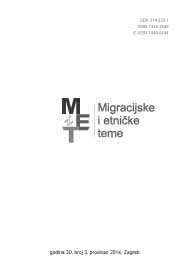Suvremena migracijska obilježja statističkih jedinica Republike Hrvatske
Current Migration Characteristics of Statistical Units of the Republic of Croatia
Author(s): Sanja Klempić Bogadi, Ivan LajićSubject(s): Social Sciences
Published by: Institut za migracije i narodnosti
Keywords: Croatia; NUTS; migration; depopulation; natural change
Summary/Abstract: The paper analyzes the basic demographic processes in the Republic of Croatia (NUTS 1), in its statistical macro-regions (NUTS 2) and counties (NUTS 3) in the inter-census period from 2001 to 2011. The theoretical part discusses the optimal structure and the establishment of statistical macro-regions, as well as the impact of demographic factors on their formation. The authors are critical of the quality and content of certain demographic categories set in the last census and their incomparability with previous censuses. Medium-intensity depopulation is still continuing; however, a large part of the Croatian territory is affected by this unfavourable characteristic of the overall population trend. Namely, in the last decade of the intercensus period, only the City of Zagreb and Zagreb County in Continental Croatia recorded an increase in population, while in Adriatic Croatia such a case was found only in the Zadar and Istria Counties. Both components of the overall population trends in Croatia – natural change and net migration – bear a negative denominator. Only two of twenty-one NUTS 3 units showed natural increase (the Split-Dalmatia and Dubrovnik-Neretva Counties), while the other counties, even the immigration ones, registered natural population decrease. It is obvious from migration data that Croatia has polarized to Zagreb and its surroundings as the economic and demographic centre of the country, and to the coastal counties that, for the most part, still have an economically attractive tourism-based economic development and migration attractiveness to some extent. Most Continental Croatian counties consist of poorly developed, peripheral areas of depopulation and demographic decline in general.
Journal: Migracijske i etničke teme
- Issue Year: 30/2014
- Issue No: 3
- Page Range: 437-477
- Page Count: 41
- Language: Croatian

